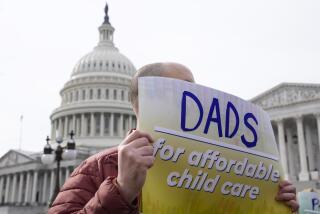Economic Compassion
- Share via
Advocates of bigger government budgets for the health and education of American children have always leaned heavily on compassion in making their case. Now they are mixing in some basic economics, and the result is a case for helping youngsters that is even more persuasive.
The staff of the House Select Committee on Children, Youth and Families has pulled together independent evaluations of eight federal programs dealing with prenatal and infant health care, immunization and education for children. It finds that the analyses provide “proof of our ability to improve the lives of millions of vulnerable American children while reducing the need for later and more costly expenditures” on such things as job training and hospital care.
Evaluations on which the report is based all appeared originally in such publications as the American Journal of Public Health and in findings of such organizations as the Centers for Disease Control and the General Accounting Office. The study shows clearly that the government is getting its money’s worth from family-oriented programs. It argues persuasively against further Reagan Administration cuts in those programs.
For example, for every $1 invested in the pre-natal portion of the women, infants and children’s supplemental food program, as much as $3 is saved in short-term hospital costs. Those hospital costs are incurred when infants are born prematurely or weighing too little to survive without special care. Yet the report says that this nutritional program reaches only about one-third of the mothers, infants and children eligible.
An analysis by the Michigan Department of Health showed that other prenatal-care programs for low-income women provided under Social Security and Medicaid saved $6.12 in intensive-care costs for every $1 spent.
Turning to the childhood-immunization program, the report found that rubella cases have dropped by 98.7% since vaccinations began in 1969, that mumps cases dropped by almost 95% between 1970 and 1982, and that reported cases of measles, polio, diphtheria, whooping cough and tetanus also dropped sharply. Again, for every $1 that is spent the government saves $10 in medical costs. And children do not face the crippling of polio or the severe problems of hearing loss and retardation that rubella often causes.
In education the consensus is that students who attended preschool programs have better grades, fewer absences from school, greater likelihood of finishing high school, increased employability, decreased criminal activity and reduced dependence on public aid. For every $1 spent on these programs, the return to society is $4.75 in savings on crime costs, welfare and improved earning ability.
Not least among the remarkable aspects of this committee report is that it is bipartisan. The call for more services is not the sniping of a party out of power at the one in power, but a joint effort of the committee chairman, Rep. George Miller (D-Martinez), and the ranking minority member, Rep. Dan Coats (R-Ind.). The report makes explicit the fact that, over time, government has learned to make sound investments that benefit children. Now Congress must find the will to make it possible for those who need them to share those benefits.
More to Read
Sign up for Essential California
The most important California stories and recommendations in your inbox every morning.
You may occasionally receive promotional content from the Los Angeles Times.













